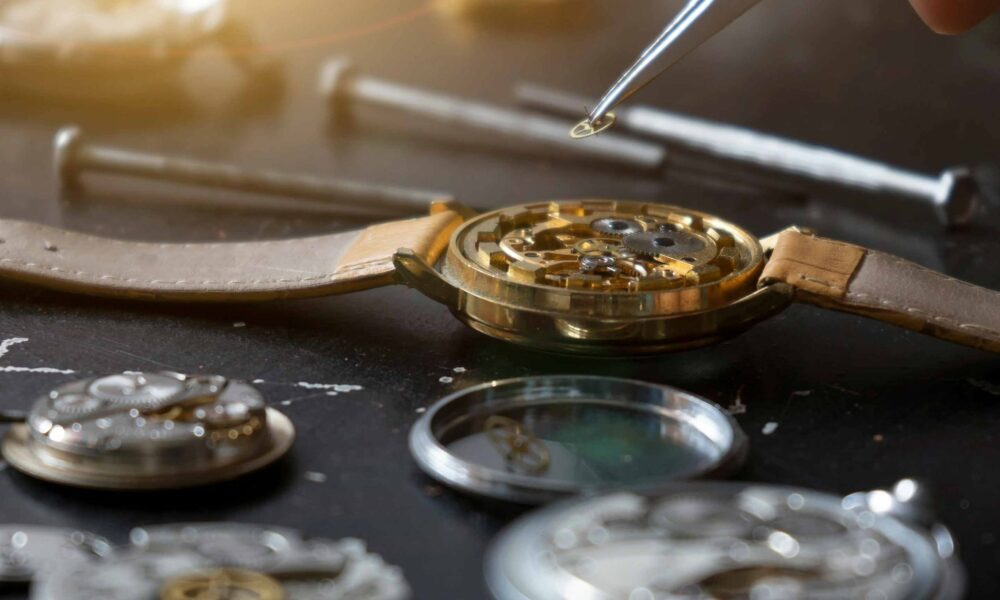10 Common Mistakes in Watch Repair

Watch repair is a delicate and intricate task requiring precision and the right tools. Whether you’re a professional watchmaker or a hobbyist, understanding the common mistakes in watch repair can save you time, effort, and costly errors. From misusing tools to neglecting essential cleaning processes, these mistakes can permanently damage your timepiece. With the increasing availability of watch repair kits, many enthusiasts attempt repairs at home, often needing proper guidance.
In this guide post, we’ll explore the ten most common mistakes in watch repair and how to avoid them. To ensure successful repairs, consider investing in a high-quality watch repair kit that provides all the necessary tools.
1. Using the Wrong Tools
One of the most frequent mistakes in watch repair is using improper tools. Watches are composed of tiny components that require specialized instruments. Using general household tools can lead to scratches, dents, and even broken parts. Always use tools specifically designed for watch repair, such as screwdrivers, tweezers, and case openers.
2. Applying Excessive Force
Applying too much force during repairs is another common error. Whether you’re opening the case back, removing the hands, or adjusting the movement, excessive force can cause irreparable damage. Patience and a gentle touch are key. If something isn’t budging, it’s better to reassess your approach rather than risk breaking a component.
3. Ignoring Proper Cleaning
Dust and dirt are the enemies of a watch’s inner workings. Failing to clean components before reassembling them can lead to poor performance or complete malfunction. Always clean each part thoroughly with appropriate cleaning solutions and use a blower to remove any residual dust before reassembly.
4. Mishandling the Movement
The movement is the heart of any watch, and mishandling it can result in serious damage. Avoid touching the movement with your fingers, as oils from your skin can transfer and cause corrosion. Use tweezers or gloves when handling delicate parts, and always ensure the movement is properly secured during the repair process.
5. Overlooking Lubrication
Proper lubrication is crucial to the smooth functioning of a watch. Many amateurs either skip this step or apply too much oil, leading to increased friction or movement slowdown. Always use the recommended amount of lubrication and the correct type of oil for each part of the watch.
6. Failing to Align the Hands
Incorrectly aligned hands can cause a watch to malfunction. This mistake often occurs when reattaching the hands after repair. Ensure the hands are properly seated and do not touch each other or the dial, as this can stop the watch or damage the hands over time.
7. Neglecting to Test the Watch
After completing repairs, it’s vital to test the watch thoroughly before considering the job done. Many people forget this step, only to find out later that the watch isn’t working correctly. Test the watch’s accuracy, power reserve, and all functions to ensure everything is operating smoothly.
8. Improperly Sealing the Case
If a watch case isn’t sealed correctly after a repair, it can compromise the watch’s water resistance and expose it to dust and moisture. Always check the gaskets and seals for wear and replace them if necessary. Use the proper tools to close the case securely to maintain the watch’s integrity.
9. Disregarding the Importance of Documentation
Forgetting to document the repair process is a mistake that can lead to confusion and errors, especially with complex repairs. Take notes or photos at each step to ensure you can reassemble the watch correctly. This is particularly important when working on unfamiliar or intricate movements.
10. Attempting Repairs Beyond Your Skill Level
The allure of fixing your own watch can lead to overconfidence, causing you to attempt repairs that are beyond your skill level. This often results in further damage to the watch. It’s essential to know your limits and seek professional help when necessary. Remember, a high-quality watch repair kit is valuable, but so is knowing when to use it and when to leave a job to the experts.
FAQs
Can I use a regular screwdriver to repair my watch?
No, regular screwdrivers are too large and can easily damage your watch. It’s important to use precision screwdrivers designed specifically for watch repair.
How often should I lubricate my watch?
Watches typically need lubrication every 3 to 5 years. However, if your watch is exposed to extreme conditions, it may require more frequent servicing.
What should I do if I accidentally misalign the hands on my watch?
If you misalign the hands, it’s best to carefully remove and reattach them, ensuring they are properly aligned and do not touch each other or the dial.
Is it necessary to replace the gasket every time I open the watch case?
It’s not always necessary, but it’s a good practice to inspect the gasket and replace it if it shows signs of wear to maintain water resistance.
Conclusion
Watch repair can be a rewarding experience when done correctly, but it’s important to be aware of the common pitfalls that can lead to mistakes. By avoiding these errors and using the proper tools and techniques, you can ensure your watch remains in top condition. Whether you’re a seasoned watchmaker or just starting out, investing in a high-quality watch repair kit and following best practices will help you achieve the best results. Remember, when in doubt, consult a professional to avoid causing further damage to your cherished timepiece.
Read More From Techbullion And Businesnewswire.com





